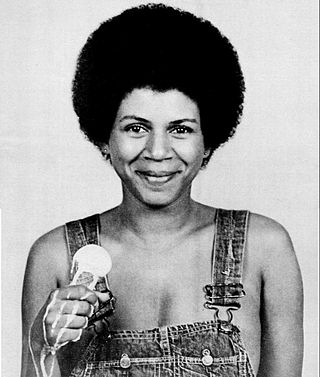Related Research Articles

A castrato is a male singer who underwent castration before puberty in order to retain singing voice equivalent to that of a soprano, mezzo-soprano, or contralto. The voice can also occur in one who, due to an endocrinological condition, never reaches sexual maturity.

A secondary sex characteristic is a physical characteristic of an organism that is related to or derived from its sex, but not directly part of its reproductive system. In humans, these characteristics typically start to appear during puberty. In animals, they can start to appear at sexual maturity. In humans, secondary sex characteristics include enlarged breasts and widened hips of females, facial hair and Adam's apples on males, and pubic hair on both. In non-human animals, secondary sex characteristics include, for example, the manes of male lions, the bright facial and rump coloration of male mandrills, and horns in many goats and antelopes.
A soprano is a type of classical female singing voice and has the highest vocal range of all voice types. The soprano's vocal range (using scientific pitch notation) is from approximately middle C (C4) = 261 Hz to "high A" (A5) = 880 Hz in choral music, or to "soprano C" (C6, two octaves above middle C) = 1046 Hz or higher in operatic music. In four-part chorale style harmony, the soprano takes the highest part, which often encompasses the melody. The soprano voice type is generally divided into the coloratura, soubrette, lyric, spinto, and dramatic soprano.
A countertenor (also contra tenor) is a type of classical male singing voice whose vocal range is equivalent to that of the female contralto or mezzo-soprano voice types, generally extending from around G3 to D5 or E5, although a sopranist (a specific kind of countertenor) may match the soprano's range of around C4 to C6. Countertenors often have tenor or baritone chest voices, but sing in falsetto or head voice much more often than they do in their chest voice.
A tenor is a type of classical male singing voice whose vocal range lies between the countertenor and baritone voice types. It is the highest male chest voice type. Composers typically write music for this voice in the range from the second B below middle C to the G above middle C (i.e. B2 to G4) in choral music, and from the second B flat below middle C to the C above middle C (B♭2 to C5) in operatic music, but the range can extend at either end. Subtypes of tenor include the leggero tenor, lyric tenor, spinto tenor, dramatic tenor, heldentenor, and tenor buffo or spieltenor.
Falsetto is the vocal register occupying the frequency range just above the modal voice register and overlapping with it by approximately one octave.

The whistle register is the highest register of the human voice, lying above the modal register and falsetto register. This register has a specific physiological production that is different from the other registers and is so called because the timbre of the notes that are produced from this register is similar to that of a whistle.
A sopranist is a male singer who is able to sing in vocal tessitura of a soprano, usually through falsetto or head voice technique. This voice type is a specific kind of countertenor. In rare cases an adult man may be able to sing in the soprano range using his normal or modal voice and not falsetto due to endocrinological reasons, like Radu Marian, or as a result of a larynx that has not completely developed as is allegedly the case of Michael Maniaci.
A male soprano or boy treble is a young male singer with a voice in the soprano range, a range that is often still called the treble voice range no matter how old.

Alessandro Moreschi was an Italian chorister of the late 19th century and the only castrato to make solo recordings.
Head voice is a term used within vocal music. The use of this term varies widely within vocal pedagogical circles and there is currently no one consistent opinion among vocal music professionals in regard to this term. Head voice can be used in relation to the following:
Vocal range is the range of pitches that a human voice can phonate. A common application is within the context of singing, where it is used as a defining characteristic for classifying singing voices into voice types. It is also a topic of study within linguistics, phonetics, and speech-language pathology, particularly in relation to the study of tonal languages and certain types of vocal disorders, although it has little practical application in terms of speech.
The tenore contraltino is a specialized form of the tenor voice found in Italian opera around the beginning of the 19th century, mainly in the Rossini repertoire, which rapidly evolved into the modern "romantic" tenor. It is sometimes referred to as tenor altino in English books.
Radu Marian is a Moldavian male soprano (sopranist).
A voice type is a group of voices with similar vocal ranges, capable of singing in a similar tessitura, and with similar vocal transition points (passaggi). Voice classification is most strongly associated with European classical music, though it, and the terms it utilizes, are used in other styles of music as well.
Puberphonia is a functional voice disorder that is characterized by the habitual use of a high-pitched voice after puberty, hence why many refer to the disorder as resulting in a 'falsetto' voice. The voice may also be heard as breathy, rough, and lacking in power. The onset of puberphonia usually occurs in adolescence, between the ages of 11 and 15 years, at the same time as changes related to puberty are occurring. This disorder usually occurs in the absence of other communication disorders.
There is no authoritative system of voice classification in non-classical music as classical terms are used to describe not merely various vocal ranges, but specific vocal timbres unique to each range. These timbres are produced by classical training techniques with which most popular singers are not intimately familiar, and which even those that are do not universally employ them.
Michael Maniaci is an American opera singer. Possessing a male soprano voice, Maniaci is noted for his claim to be able to sing into the upper soprano range without resorting to falsetto, an otherwise common phonation for men who sing in high registers, such as countertenors. Although this was possible for castrati because of the hormonal imbalance following castration, Maniaci claims that, for some unknown reason, his larynx did not develop and lengthen completely during puberty, causing his voice not to "break" in the usual manner. Maniaci claims that this physical particularity has given him the ability to sing in the soprano register without sounding like a typical countertenor or a female singer. There are, however, critics who claim that Maniaci actually sings in falsetto.
A boys' choir is a one made up of boys who have yet to begin puberty and so retain their high-pitched childhood voice. Members are known as trebles or meanes, depending on their range. Boys' choirs of churches or cathedrals on both sides of the Atlantic may sing alongside and train with men, who provide the tenor and bass parts, in a tradition that dates back traceably to the 7th century, in the case of York Minster, and probably much further.
Voice break generally refers to transitions between different vocal registers of the human voice. Although singing is mostly done using the modal register, it is important for more professional singers to be able to smoothly move between different vocal registers.
References
- 1 2 "Your child's changing voice". Kidshealth.org.
- ↑ "Breaking voices". BBC Science. 30 April 2002. Retrieved 7 January 2012.
- ↑ "Voice changing". The Lowdown. Retrieved 7 January 2012.
- 1 2 "When will my son's voice change?". About.com.
- ↑ John Rosselli, "Castrato" article in The New Grove Dictionary of Music and Musicians, 2001.
- ↑ Ellis, Samantha (5 August 2002). "All Mouth and No Trousers". The Guardian . Archived from the original on 9 September 2014.
- ↑ Mainzer, Joseph (1848). "Music and Education".